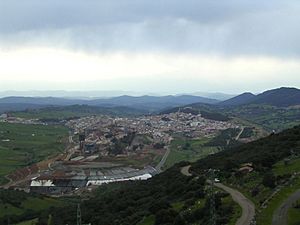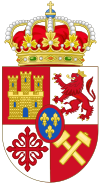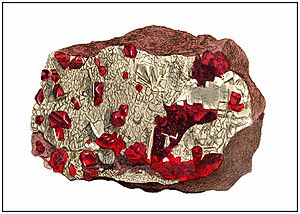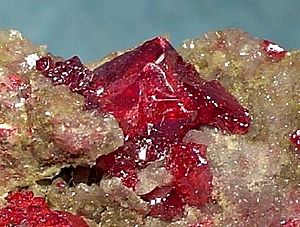Almadén facts for kids
Quick facts for kids
Almadén
|
|||
|---|---|---|---|

Almadén in 2007
|
|||
|
|||
| Country | |||
| Autonomous community | Castile-La Mancha | ||
| Province | Ciudad Real | ||
| Comarca | Almadén (comarca) | ||
| Area | |||
| • Total | 239.64 km2 (92.53 sq mi) | ||
| Elevation | 589 m (1,932 ft) | ||
| Population
(2018)
|
|||
| • Total | 5,461 | ||
| • Density | 22.7883/km2 (59.022/sq mi) | ||
| Demonyms | Almadenense, sa | ||
| Time zone | UTC+1 (CET) | ||
| • Summer (DST) | UTC+2 (CEST) | ||
| Postal code |
13400
|
||
| Official name: Heritage of Mercury. Almadén and Idrija | |||
| Type: | Cultural | ||
| Criteria: | ii, iv | ||
| Designated: | 2012 (36th session) | ||
| Reference #: | 1313 | ||
| Region: | Europe and North America | ||
Almadén is a town and municipality in the Spanish province of Ciudad Real. It is part of the Castile-La Mancha region. The town is about 300 km south of Madrid. It sits 589 meters above sea level.
The name Almadén comes from an Arabic word meaning "the metal" or "the mine". This name makes sense because Almadén is famous for its mercury mines. The town was first a Roman mining settlement. Later, it was controlled by the Moors. In 1151, Christian forces led by King Alfonso VII took the town. They gave it to the Knights of the Order of Calatrava.
Almadén has the largest amount of liquid mercury metal ever found in the world. Over the past 2,000 years, about 250,000 metric tons of mercury have been produced here. Mercury and its byproducts can be harmful to people. Because of this, the mine used different types of workers throughout its long history.
The Almadén mine stopped working in 2002. This was because of a European rule against mercury mining. In 2006, the mine opened to the public. Visitors can now explore the first level, which is 50 meters underground. In 2012, Almadén and Idrija in Slovenia were named World Heritage Sites. This honor recognized their shared "Heritage of Mercury."
Contents
Exploring the History of Almadén Mines
The land around Almadén has a lot of volcanism. This means there was once a lot of volcanic activity. Almadén holds the world's biggest supply of cinnabar. Cinnabar is a mineral that forms near volcanoes. Mercury is taken out of cinnabar.
In ancient times, cinnabar was used to make a red color called vermillion. This was likely why the Romans and Visigoths mined it. During the Islamic era, new furnaces were built. These furnaces could get mercury from cinnabar. With better knowledge, the mines of Almadén sent mercury all over the Mediterranean Sea.
Who Managed the Mines?
In the 1500s and 1600s, two German bankers called the Fuggers managed the mines. They did this in exchange for loans to the Spanish government. Mercury became very important in the Americas in the mid-1500s. This was because of a process called amalgamation. This process uses mercury to get gold and silver from rocks.
As more mercury was needed, Almadén became a very important mining town. Most of the mercury made then went to Seville. From there, it was sent to the Americas.
Working Conditions in the Mines
Working in the mines was very dangerous. It was hard for the Fuggers to find people willing to work there. As the need for mercury grew, the mines started using people who were serving sentences.
Workers Serving Sentences
In 1566, the King of Spain agreed to send 30 people to work at Almadén. These workers were serving sentences for crimes. This number grew to 40 by 1583. These workers were chosen from jails in Toledo. They usually had shorter sentences and were physically strong.
A royal investigator named Mateo Alemán looked into the living conditions in 1593. He talked to many of the workers. The mine tried to provide decent living conditions. Each worker received daily food like meat, bread, and wine. They also got new clothes each year. Medical care was available, and the mine even had its own pharmacy.
However, the risk of getting sick or dying from mercury poisoning was always there. Many workers experienced pain, shaking, and even mental problems. Most of the men who worked near the furnaces died from poisoning.
Workers also had to pump water out of the mines. This was very tiring. A group of four men had to pump out 300 buckets of water without stopping. If they couldn't meet this goal, they were punished. Even sick workers were expected to do this.
Many workers died, and their fellow workers wanted to give them proper burials. They formed a religious group to help with this. Mass was held on Sundays and holidays.
Enslaved Workers
People who were abducted for slavery, mostly from North Africa, were also bought to work in the mines. These enslaved people were often those their owners didn't want. This made them cheaper to buy. The work was so dangerous that buying enslaved people at the usual market price would have been too expensive. By 1613, there were twice as many enslaved workers as those serving sentences.
Changes Over Time
In 1645, the Spanish government took over the mines from the Fuggers. In 1749, a rule said that all serious criminals should be sent to Almadén. But the mine couldn't hold everyone, so this rule was stopped in 1751.
Two big fires happened in 1775. People blamed the workers who were serving sentences. Later in the 1700s, safer mining methods were introduced. More free workers became interested in the mine. By the end of the century, most enslaved workers had been replaced by free workers. The system of using people serving sentences ended in 1801.
In 1835, the mine was leased to a bank called N M Rothschild & Sons. This bank also owned a mercury mine in Slovenia. This gave them a lot of control over the mercury market. They made a lot of money for both Spain and their company. Spain took back the mine in 1863.
In 1916, a special group was created to run the mines. They brought in new technology and made safety better. In 1941, just after the Spanish Civil War, the mine produced a record 82,000 mercury flasks. This was done using prisoners of war as workers.
The price of mercury dropped a lot from 1965 to 1976. This made it hard to plan for the mine's future. In 1981, the Spanish government created a company to operate the mine. In 2000, the mines closed because the price of mercury fell even more. This was due to less demand for mercury around the world. Even so, Almadén still has one of the world's largest mercury resources.
Almadén as a Heritage Site
Today, Almadén is a World Heritage Site. It is part of the "Heritage of Mercury. Almadén and Idrija" site. A museum has been built there. Visitors can go into parts of the mines that date from the 1500s to the 1900s.
The International Union of Geological Sciences (IUGS) has called Almadén "the largest known mercury deposit on Earth." They also noted its long history of production, going back to the 3rd century BCE. Because of this, the IUGS included Almadén in its list of 100 world "geological heritage sites" in 2022. These sites are important places for understanding geology.
See also
 In Spanish: Almadén para niños
In Spanish: Almadén para niños







